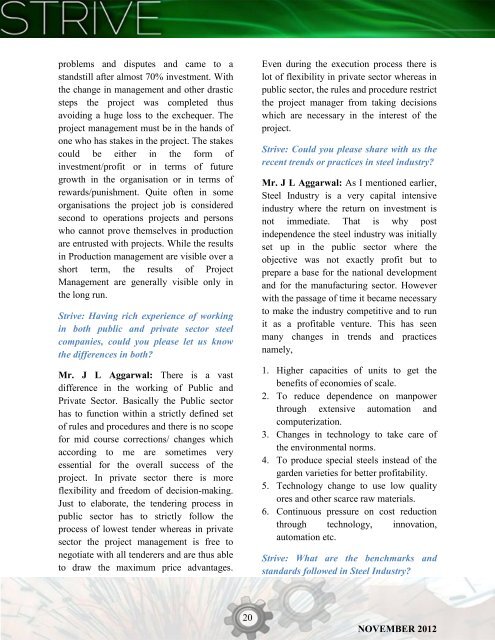sTRIVE final.pdf
You also want an ePaper? Increase the reach of your titles
YUMPU automatically turns print PDFs into web optimized ePapers that Google loves.
problems and disputes and came to a<br />
standstill after almost 70% investment. With<br />
the change in management and other drastic<br />
steps the project was completed thus<br />
avoiding a huge loss to the exchequer. The<br />
project management must be in the hands of<br />
one who has stakes in the project. The stakes<br />
could be either in the form of<br />
investment/profit or in terms of future<br />
growth in the organisation or in terms of<br />
rewards/punishment. Quite often in some<br />
organisations the project job is considered<br />
second to operations projects and persons<br />
who cannot prove themselves in production<br />
are entrusted with projects. While the results<br />
in Production management are visible over a<br />
short term, the results of Project<br />
Management are generally visible only in<br />
the long run.<br />
Strive: Having rich experience of working<br />
in both public and private sector steel<br />
companies, could you please let us know<br />
the differences in both?<br />
Mr. J L Aggarwal: There is a vast<br />
difference in the working of Public and<br />
Private Sector. Basically the Public sector<br />
has to function within a strictly defined set<br />
of rules and procedures and there is no scope<br />
for mid course corrections/ changes which<br />
according to me are sometimes very<br />
essential for the overall success of the<br />
project. In private sector there is more<br />
flexibility and freedom of decision-making.<br />
Just to elaborate, the tendering process in<br />
public sector has to strictly follow the<br />
process of lowest tender whereas in private<br />
sector the project management is free to<br />
negotiate with all tenderers and are thus able<br />
to draw the maximum price advantages.<br />
Even during the execution process there is<br />
lot of flexibility in private sector whereas in<br />
public sector, the rules and procedure restrict<br />
the project manager from taking decisions<br />
which are necessary in the interest of the<br />
project.<br />
Strive: Could you please share with us the<br />
recent trends or practices in steel industry?<br />
Mr. J L Aggarwal: As I mentioned earlier,<br />
Steel Industry is a very capital intensive<br />
industry where the return on investment is<br />
not immediate. That is why post<br />
independence the steel industry was initially<br />
set up in the public sector where the<br />
objective was not exactly profit but to<br />
prepare a base for the national development<br />
and for the manufacturing sector. However<br />
with the passage of time it became necessary<br />
to make the industry competitive and to run<br />
it as a profitable venture. This has seen<br />
many changes in trends and practices<br />
namely,<br />
1. Higher capacities of units to get the<br />
benefits of economies of scale.<br />
2. To reduce dependence on manpower<br />
through extensive automation and<br />
computerization.<br />
3. Changes in technology to take care of<br />
the environmental norms.<br />
4. To produce special steels instead of the<br />
garden varieties for better profitability.<br />
5. Technology change to use low quality<br />
ores and other scarce raw materials.<br />
6. Continuous pressure on cost reduction<br />
through technology, innovation,<br />
automation etc.<br />
Strive: What are the benchmarks and<br />
standards followed in Steel Industry?<br />
20<br />
NOVEMBER 2012







